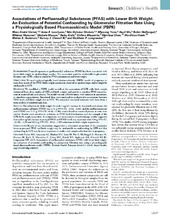| dc.rights.license | Copyright law does not apply to Environmental Health Perspectives, which falls within the public domain. | |
| dc.contributor.author | Verner, Marc-André | en_US |
| dc.contributor.author | Loccisano, Anne E. | en_US |
| dc.contributor.author | Morken, Nils-Halvdan | en_US |
| dc.contributor.author | Yoon, Miyoung | en_US |
| dc.contributor.author | Wu, Huali | en_US |
| dc.contributor.author | McDougall, Robin | en_US |
| dc.contributor.author | Maisonet, Mildred | en_US |
| dc.contributor.author | Marcus, Michele | en_US |
| dc.contributor.author | Kishi, Reiko | en_US |
| dc.contributor.author | Miyashita, Chihiro | en_US |
| dc.contributor.author | Chen, Mei-Huei | en_US |
| dc.contributor.author | Hsieh, Wu-Shiun | en_US |
| dc.contributor.author | Andersen, Melvin E. | en_US |
| dc.contributor.author | Clewell, Harvey J. | en_US |
| dc.contributor.author | Longnecker, Matthew P. | en_US |
| dc.date.accessioned | 2016-06-22T12:48:17Z | |
| dc.date.available | 2016-06-22T12:48:17Z | |
| dc.date.issued | 2015-12 | |
| dc.Published | Environmental Health Perspectives 2015, 123(12):1317-1324 | eng |
| dc.identifier.issn | 0091-6765 | |
| dc.identifier.uri | https://hdl.handle.net/1956/12164 | |
| dc.description.abstract | Background: Prenatal exposure to perfluoroalkyl substances (PFAS) has been associated with lower birth weight in epidemiologic studies. This association could be attributable to glomerular filtration rate (GFR), which is related to PFAS concentration and birth weight. Objectives: We used a physiologically based pharmacokinetic (PBPK) model of pregnancy to assess how much of the PFAS–birth weight association observed in epidemiologic studies might be attributable to GFR. Methods: We modified a PBPK model to reflect the association of GFR with birth weight (estimated from three studies of GFR and birth weight) and used it to simulate PFAS concentrations in maternal and cord plasma. The model was run 250,000 times, with variation in parameters, to simulate a population. Simulated data were analyzed to evaluate the association between PFAS levels and birth weight due to GFR. We compared simulated estimates with those from a meta-analysis of epidemiologic data. Results: The reduction in birth weight for each 1-ng/mL increase in simulated cord plasma for perfluorooctane sulfonate (PFOS) was 2.72 g (95% CI: –3.40, –2.04), and for perfluorooctanoic acid (PFOA) was 7.13 g (95% CI: –8.46, –5.80); results based on maternal plasma at term were similar. Results were sensitive to variations in PFAS level distributions and the strength of the GFR–birth weight association. In comparison, our meta-analysis of epidemiologic studies suggested that each 1-ng/mL increase in prenatal PFOS and PFOA levels was associated with 5.00 g (95% CI: –21.66, –7.78) and 14.72 g (95% CI: –8.92, –1.09) reductions in birth weight, respectively. Conclusion: Results of our simulations suggest that a substantial proportion of the association between prenatal PFAS and birth weight may be attributable to confounding by GFR and that confounding by GFR may be more important in studies with sample collection later in pregnancy. | en_US |
| dc.language.iso | eng | eng |
| dc.publisher | The National Institute of Environmental Health Sciences | eng |
| dc.title | Assfociations of perfluoroalkyl substances (PFAS) with lower birth weight: An evaluation of potential confounding by glomerular filtration rate using a physiologically based pharmacokinetic model (PBPK) | en_US |
| dc.type | Peer reviewed | |
| dc.type | Journal article | |
| dc.date.updated | 2016-04-07T08:23:42Z | |
| dc.description.version | publishedVersion | en_US |
| dc.identifier.doi | https://doi.org/10.1289/ehp.1408837 | |
| dc.identifier.cristin | 1313354 | |
| dc.subject.nsi | VDP::Medisinske Fag: 700::Helsefag: 800 | en_US |
